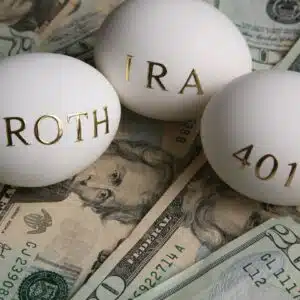When it comes to the Roth IRA vs. the Roth 401(k), there are many similarities to keep in mind. For example, both plans let investors build up tax-free income for retirement, yet both fail to offer any upfront tax benefits in the year you contribute.
That said, there’s one major difference between the Roth IRA and the Roth 401(k). One of these plans is an employer-sponsored plan, and the other is a self-directed account that you can open on your own if you’re eligible.
With that in mind, it’s not surprising that the IRS allows certain specific benefits for each plan type. Read on to learn about the advantages of each of these accounts and other details to consider when you’re looking at the Roth IRA versus the Roth 401(k).
Table of Contents
Roth IRA vs. Roth 401(k) – The Similarities
On the surface, the two Roth plan types seem to be identical. Here are some of the main similarities you should know about before you consider opening one or both of these accounts.
Both Provide Tax-Free Distributions in Retirement
The biggest distinguishing factor about these two Roth plans is the fact they create the opportunity to build up a tax-free income source in retirement. This benefit is available whether you have a Roth IRA or a Roth 401(k) plan.
In order to qualify for tax-free income in retirement, distributions that include earnings cannot be taken before you reach age 59 ½. In addition, you must be participating in a Roth plan for a minimum of five years at the time distributions are taken. But, as long as you meet those two criteria, the distributions you receive from the plan will be tax-free.
This makes Roth plans completely different from other tax-sheltered retirement plans, such as traditional IRAs and regular 401(k) plans. All other retirement plans are merely tax-deferred. That means that, while you get generous tax benefits during the accumulation phase of the plan with a 401(k), you will have to pay ordinary income tax when you begin taking distributions in retirement.
In this way, both Roth IRAs and Roth 401(k) plans provide excellent tax diversification strategies for retirement. This means either will allow you to have at least some tax-free income along with other income sources that are fully taxable.
Neither Offers Tax-Deductible Contributions
When you make a contribution to a Roth plan, whether it’s a Roth IRA or a Roth 401(k) account, there is no tax deduction upfront. This is unlike both traditional IRAs and 401(k) plans, where contributions are generally fully deductible in the year they’re made.
In fact, tax-deductibility of contributions is one of the major reasons why people participate in retirement plans. If you use a plan that does let you deduct your contributions upfront (i.e. a traditional 401k retirement plan), you get to lower your taxable income in the year you contribute.
You Can Withdraw Your Contributions From either Plan at Any Time – Tax-Free
Another unique feature of both Roth accounts is the fact you can withdraw your contributions at any time without having to pay either ordinary income tax or the 10% early withdrawal penalty on the distributions. This is in part because Roth IRA contributions are not tax-deductible at the time they are made.
But it’s also true because of IRS ordering rules for distributions that are unique to Roth plans. Those ordering rules enable you to take distributions of contributions ahead of accumulated investment earnings.
There is some difference in exactly how early distributions are handled among Roth IRAs and Roth 401(k)s.
Early distributions from Roth IRAs enable you to first withdraw your contributions – which were not tax-deductible – and then your accumulated investment earnings once all of the contributions have been withdrawn. This provides owners of Roth IRAs with the unique ability to access their money early, without incurring tax consequences.
With Roth 401(k)s, on the other hand, the contribution portion of your plan can also be withdrawn free of both ordinary income tax and early withdrawal penalties. But since they’re 401(k)s, they’re also subject to pro-rata distribution rules.
If you have a Roth 401(k) with $20,000 invested ($14,000 in contributions and $6,000 in investment earnings) then 30% ($6,000 divided by $20,000) of any early distribution that you take will be considered as investment income.
If you take a $10,000 early distribution, $3,000 of it, or 30%, will be considered investment income and subject to both income tax and the 10% early withdrawal penalty. The remaining $7,000, or 70%, will be considered a withdrawal of contributions, and therefore not subject to tax or penalty.
Both Offer Tax-Deferred Investment Returns
Despite the lack of contribution deductibility, both plans have one major feature in common with other retirement plans. With both the Roth IRA and the Roth 401(k), money contributed to the plans will accumulate investment income on a tax-deferred basis.
So, how can an account that is supposedly tax-free in retirement, be merely tax-deferred during the accumulation phase?
It comes down to early withdrawals. We’ve already discussed how you can withdraw your contributions early from either a Roth IRA or Roth 401(k) without creating a tax liability. But if your distributions also include investment earnings, the situation is different.
Accumulated Investment Earnings Are Taxable if Withdrawn Early
Whether you have a Roth IRA or a Roth 401(k), if you take distributions from either plan that includes investment earnings (which it will under the pro-rata rules for the Roth 401(k)), and you are either under age 59 ½ or have been participating in the Roth plan for less than five years), those earnings will create a tax liability.
Let’s say you have been taking early distributions from your Roth plan. You have already withdrawn the full amount of your contributions to the plan. You continue taking distributions, but you are now withdrawing funds that represent accumulated investment earnings.
Those withdrawals – the ones that are composed of accumulated investment earnings – will be subject not only to ordinary income tax but also the 10% early withdrawal penalty. In this way, early distributions from a Roth plan are handled the same way they are for other retirement plans, at least in regard to the withdrawal of investment earnings.
Distributions From Either Won’t Affect the Taxability of Your Social Security Benefits
This is another advantage that applies to both the Roth IRA and the Roth 401(k) plan.
Distributions from other retirement plans are added to your taxable income in retirement. Not only will those distributions be subject to income tax, but they will also affect your income in calculating how much of your Social Security income will be subject to income tax.
Under current law, Social Security income is subject to income tax using a two-tiered calculation. If your combined retirement income falls below one of these limits, then your Social Security benefits are not taxable. However, if you are single and your combined income exceeds $25,000, then 50% of your Social Security benefit will be taxable.
If you’re married filing jointly and your combined income exceeds $44,000, then 85% of your Social Security benefit will be taxable.
Note that the term “combined income” refers to income from all other sources – investment income like interest, dividends, and capital gains; other retirement income, like pensions and distributions from traditional IRAs and 401(k)s; and any earned income.
Amazingly, your Roth plan distributions don’t count toward that calculation! For Social Security purposes, it’s as if the distributions from your Roth plans don’t exist. Since they’re not taxable, they’re not included in “combined income” and will be excluded from the threshold calculations.
This is yet another way Roth plans provide for tax diversification in retirement.
Similarities Between Roth IRA and Roth 401(k)
| Feature | Roth IRA | Roth 401(k) |
|---|---|---|
| Tax-Free Distributions in Retirement | Available with Specific Conditions | Available With Specific Conditions |
| Non-Deductible Contributions | No Upfront Tax Deduction | No Upfront Tax Deduction |
| Tax-Free Early Withdrawals | Contributions Can Be Withdrawn Tax-Free | Contributions Can Be Withdrawn Tax-Free |
| Tax-Deferred Investment Returns | Contributions and Investment Income Grow Tax-Deferred | Contributions and Investment Income Grow Tax-Deferred |
| Social Security Benefits Not Affected | Distributions Don’t Impact Social Security Taxability | Distributions Don’t Impact Social Security Taxability |
That covers the similarities between Roth IRAs and Roth 401(k)s. But let’s move on to the differences,
Differences Between Roth IRA and Roth 401(k)
Most of the differences between the Roth IRA and Roth 401(k) have to do with the fact the Roth 401(k) is offered as an employer-sponsored plan. That by itself creates a lot of differences, including the following.
Contribution Amounts
The maximum you can contribute to a Roth IRA in 2023 is $7,000, or $8,000 if you’re age 50 or older. This is an increase from previous years.
That said, Roth 401(k) contributions are potentially more than three times higher!
The employee contribution limit for 2024 for a Roth 401(k) plan is $23,000 per year, or $30,500 if you are age 50 or older (up from $20,500 and $27,000 for 2022). If you participate in a 401(k) plan that also has a Roth 401(k) provision, you could actually contribute up to the maximum 401(k) contribution limit entirely to your Roth 401(k).
Now, that doesn’t mean you want to contribute the entire amount to the Roth portion. After all, the Roth 401(k), being a Roth plan, does not offer tax-deductible contributions. Depending on your age, $23,000 or $30,500 may be a lot of money to take out of your paycheck without getting a tax break. But, it still gives you a lot more room to allocate funds to a Roth plan than what you can with a Roth IRA account.
Employer Matching Contributions
As an employer-sponsored retirement plan, you can also get an employer-matching contribution in a Roth 401(k) plan. Since the Roth IRA is a self-directed account, the employer match does not exist.
Though not all employers offer either the Roth 401(k) or even an employer matching contribution, the ones that do may not make a distinction between a regular 401(k) and the Roth portion. In that situation, if the employer offers a 50% match on your contribution, that means there will be a 50% match on the part of your contribution that goes into your Roth 401(k).
There is one limitation on the employer match, however. Since a Roth 401(k) is a fully segregated account in your retirement plan, the employer cannot put matching contributions into that part of your plan. Instead, the employer match goes into your regular 401(k) plan.
That means that, even if you were to allocate 100% of your 401(k) contribution into the Roth portion, you would still have a regular 401(k) if the employer offers a match.
While it would be an advantage to have the employer match going into the Roth 401(k) as well, that would create a tax problem. Since the employer match is not taxable to you when made, it would be taxable when you begin taking distributions from the plan. For this reason, you’re better off having it in the regular 401(k) portion of your plan, where it will be tax-deferred.
Loan Provisions
Since a Roth 401(k) is part of an employer-sponsored plan, a loan provision may be available on it.
Not all employers offer loan provisions on their 401(k) plans. But if they do, the IRS permits you to borrow up to 50% of the vested balance of your account, up to a maximum of $50,000. Naturally, if you do take the loan against your plan, you will have to make monthly payments, including interest, until the loan is repaid.
Once again, since a Roth IRA is a self-directed plan, no loan provision is available.
Required Minimum Distributions (RMDs)
This is where a Roth IRA and a Roth 401(k) are completely different. IRS required minimum distribution (RMD) rules require that you begin taking mandatory distributions from your tax-sheltered retirement plan beginning at age 73. However, if the Secure Act 2.0 were to pass both houses of Congress and become law, the age you are required to begin taking RMDs could increase to 75 over the next decade,
Whatever age you wind up having to take RMDs, withdrawals are based on a percentage calculated based on your remaining life expectancy at the age that each distribution is made.
Either way, the difference between these two accounts is obvious here. Roth 401(k) plans are subject to RMD provisions, whereas Roth IRA accounts are not.
The benefit of not being required to take RMDs is you can allow your Roth IRA to grow for the rest of your life. This will enable you to leave a larger amount of money to your heirs upon your death.
**A Roth IRA is an excellent strategy to avoid outliving your money. Since RMDs are not required, the money in a Roth IRA can be available for the later years of retirement, when other plans may have been severely drawn down.
Income Limits
There are no income limits restricting your ability to make Roth 401(k) contributions. As long as you’re participating in the 401(k) plan, you’re able to make contributions to a Roth 401(k).
However, this is not true with a Roth IRA at all. If your income exceeds certain limits, you will not be able to make a contribution to this type of account directly.
For 2024, the Roth IRA income limits look like this:
- Married filing jointly, or qualifying widow(er) – allowed up to an income of $230,000, partial contributions allowed between $230,000 and $240,000, after which no contribution is allowed.
- Married filing separately – partial contribution on an income up to $10,000, after which no contribution is allowed.
- Single, head of household, or married filing separately AND you did not live with your spouse at any time during the year – allowed up to an income of $146,000, partial contributions allowed between $146,000 and $161,000, after which no contribution is allowed.
Trustee and Investment Selection
This is another area that usually favors Roth IRA plans. As a self-directed account, a Roth IRA can be held with the trustee of your choosing. That means you can decide on an investment platform for the account that meets your requirements for both fees and investment selection.
You can choose a platform that charges low fees, as well as one that offers the widest variety of potential investments. You can even open your Roth IRA with one of the best online brokerage firms.
But with a Roth 401(k), since it’s part of an employer-sponsored plan, you will likely have no choice in the matter. This is one of the biggest issues people have with employer-sponsored plans. The trustee selected by the employer may charge higher than normal fees.
They also commonly restrict your investment options. For example, while you might choose a trustee for a Roth IRA that has virtually unlimited investment options, the trustee for a Roth 401(k) may limit you to no more than half a dozen investment choices.
Differences Between Roth IRA and Roth 401(k)
| Feature | Roth IRA | Roth 401(k) |
|---|---|---|
| Contribution Amounts | Maximum $7,000 in 2024 ($8,000 if 50 or Older) | Employee Contribution Limit $23,000 in 2024 ($30,500 if 50 or Older) |
| Employer Matching Contributions | Not Applicable | May Include Employer Matching Contributions |
| Loan Provisions | Not Available | May Offer Loan Provisions |
| Required Minimum Distributions (RMDs) | Not Required | Subject to RMD Rules |
| Income Limits | Income Limits for Direct Contributions | No Income Limits for Contributions |
| Trustee and Investment Selection | Flexible Trustee and Investment Selection | Limited Trustee and Investment Options Under Employer Sponsorship |
Roth IRA vs Roth 401k: Which Will Work Better for You?
Fortunately, most people won’t have to make a choice between a Roth IRA and a Roth 401(k). That’s because current law allows you to have both. That is, you can have a 401(k) plan with a Roth 401(k) provision and still fund a Roth IRA. You can do that as long as your income does not exceed the limits required for making a Roth IRA contribution.
There’s also a maximum combined limit for contributions to all retirement plans. For 2024, it’s $69,000, or $76,500 if you’re 50 or older. The Roth 401(k), because it is part of a 401(k) plan in general, provides much higher contribution limits. This will enable you to save a very large amount of money.
As well, you always have the choice to allocate some of your 401(k) contributions into a regular 401(k). That means that the portion contributed to the traditional 401(k) will be tax-deductible.
Still, the big advantage to also having the Roth IRA is the fact you can access many more investment options. That means you can make the best of the investment selections offered within your 401(k) plan, but still expand your investing activities through your Roth IRA based on your goals.
Finally, don’t forget that having a Roth IRA means you will already have an account in place if you leave your employer and need an account to transfer your Roth 401(k) into. In addition, you could also do a Roth IRA conversion of the balance that’s in your traditional 401(k) plan.
At the end of the day, all of this means that you should take advantage of both the Roth IRA and the Roth 401(k) plan if you have the option to do both.








Good article. I do have a question, if I rollover money from a Roth 401k into a Self-directed Roth IRA, would that remove the RMDs related to the Roth 401k?
If one has the opportunity to participate in both an employer’s Roth 401K and a self directed Roth IRA, do the contribution limits change (i.e. if the Roth 401K limit is $18,500 and the Roth IRA is $5500, does contributing $5500 to the Roth IRA lower the Roth 401K limit by that same amount to that I can only contribute $13,000?)
Hi Ken – According to my research, you can contribute the full amount to both. For example, you can make the full $18,500 Roth 401(k) contribution, but also contribute $5500 to a Roth IRA. That will give you a total of $24,000. Of course the limitation is that neither contribution will be tax-deductible. I don’t know what your income situation is, but if you can afford to make a contribution that large, my guess is you’ll need at least some of the 401(k) being traditional for the tax deduction. You’ll really want to crunch numbers on this one.
Similar to Alan’s question. When you role a Roth 401K into a Roth IRA is the requirement to have equal withdraws across investments and contributions removed?
Basically Jon. But it all depends on when the rollover is done. If you have already reached 70 1/2, then the RMD will need to be done for that year. But it will no longer be required in the years after the rollover has been completed.
Jeff, if you rollover your Roth 401(k) to a Roth IRA, does that now exclude the funds from the RMD calculation?
Hi Alan – It does. It’s easy to do too since there’s no tax due on the rollover.